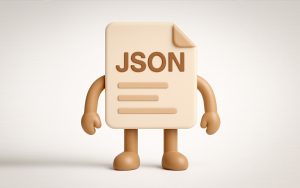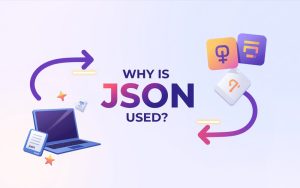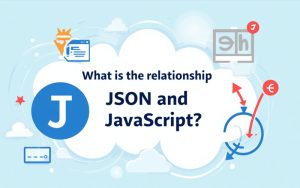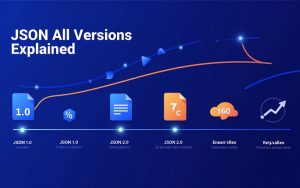
JSON stands for JavaScript Object Notation.
It is a lightweight data format used to store and exchange data between computers, applications, and servers.
JSON is written in simple text and is easy to read for humans and easy to understand for machines.
It is widely used in web development, APIs, mobile apps, and data communication.
Although JSON comes from JavaScript, it is now used with many programming languages like Python, PHP, Java, C#, and more.
In short, JSON helps in sharing data in a clear, organized, and fast way between different systems.
Why Is JSON Used?

JSON (JavaScript Object Notation) is used because it is a simple, lightweight, and universal format to share data between different systems, applications, and devices.
Here’s why JSON is so popular:
1. Easy to Read and Understand
JSON data is written in plain text. Its structure is very simple, using key-value pairs. This makes it easy for humans to read and understand, even for beginners.
2. Language-Independent
JSON is not limited to any specific programming language. Whether you are using JavaScript, Python, Java, PHP, or any other language, all of them can easily read and write JSON data. This makes JSON the best choice for data exchange between different technologies.
3. Perfect for APIs and Web Services
Most websites and apps use APIs to send and receive data. JSON is the most common format used in APIs because it is fast, lightweight, and easy to process. It helps front-end apps (like mobile apps or websites) to communicate with back-end servers smoothly.
4. Ideal for Configuration Settings
JSON is often used to store configuration data in files. These files may contain important information like database details, API keys, or user settings. JSON makes it simple to manage these settings without changing the actual code.
5. Lightweight and Faster
Compared to other formats like XML, JSON is smaller in size and quicker to parse. This improves the performance of web applications and reduces data transfer time.
6. Widely Supported
All modern web technologies, frameworks, and platforms support JSON. Its popularity means there are many tools and libraries available for working with JSON easily.
What is the relationship between JSON and JavaScript?

JSON (JavaScript Object Notation) is a lightweight data format that comes from JavaScript’s way of writing objects. It was originally designed for JavaScript, but today, almost all programming languages can use JSON to send and receive data. JSON is very simple, easy to read, and works perfectly for sharing data between web browsers and servers. Because of this, JSON has become a universal standard for data exchange on the web.
JSON All Versions Explained?

👉 JSON does not have multiple official versions like software.
Official JSON Standard:
JSON was officially defined in 2001 by Douglas Crockford.
The most recognized version is:
RFC 8259 (2017) — The latest official specification.
Older versions: RFC 4627 (2006).
Why only one main version?
JSON is simple and stable.
Its structure (key-value pairs, arrays, objects) has never changed much.
Updates only clarified rules, not added new features.
JSON Popular Formats (Not Versions but Variations)
While JSON itself has one main version, there are some popular formats and variations used in tech:
Format Explanation
JSON5 Allows comments, trailing commas, easier syntax for developers.
GeoJSON Used for geographic data (maps, locations).
JSON-LD Linked Data format, used in SEO & search engines.
NDJSON (Newline-Delimited JSON) Stores multiple JSON objects in separate lines for large data files.
Which version of JSON is used in today?

The current and most widely used version of JSON today is based on the official standard called RFC 8259, which was published in 2017. This version defines how JSON should be structured and used for data exchange.
In reality, JSON does not have multiple versions like software updates (for example, v1, v2, v3). The format of JSON is very simple and has not changed much since it was created. Over the years, only small clarifications and improvements have been made to make it more clear and reliable, but the basic structure remains the same.
Most modern applications, websites, APIs, and programming languages follow the RFC 8259 standard JSON format. Therefore, when people ask about the version of JSON used today, the correct answer is RFC 8259.
Conclusion:
In simple words, JSON (JavaScript Object Notation) is a popular and easy way to store and share data between websites, apps, and servers. Even though JSON comes from JavaScript, it works with many other programming languages like Python, PHP, Java, and more.
JSON is very popular because:
- It is simple to read and easy to write.
- It works with all modern technologies.
- It is lightweight and fast for data exchange.
- It is perfect for APIs, web services, and settings files.
The official JSON format used today follows the RFC 8259 standard (from 2017), which defines how JSON should be structured. JSON itself is stable and does not have different versions like other software.
In short, JSON helps developers exchange data in a clean, organized, and fast way, making it a very important tool in web development and programming.
FAQs
What is JSON?
JSON (JavaScript Object Notation) is a simple text format used to store and share data between computers, websites, and apps. It organizes data using key-value pairs that are easy for humans to read and easy for machines to understand. JSON is widely used in web development, APIs, mobile apps, and server communication because it is lightweight, fast, and works with many programming languages like JavaScript, Python, PHP, and more.
- What is JSON used for in simple words?
JSON is used to store and exchange data between websites, apps, and servers. It helps in sending information in a simple and organized way that both humans and machines can understand easily.
- What is the latest version of JSON?
JSON does not have versions like software updates. The current official standard is RFC 8259, published in 2017. JSON’s structure has remained simple and stable, with only small clarifications over the years.

